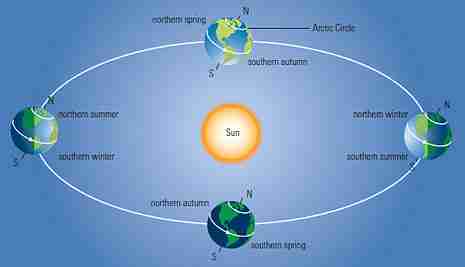Prekinder to Grade 2 Mathematics
Seasons
Seasons
Each year is divided up into seasons according to the weather. In most of the world (outside the tropics) there are four seasons. They are spring, summer, autumn and winter. North Americans
call autumn the fall because it is the time of year when leaves fall off the trees.
Some parts of Australia (and the world) are tropical. Places which are tropical like Far North Queensland, the Top End of the Northern Territory and the Kimberley have only two seasons each year: the wet season and the dry season.


Spring is the time of year when everything starts to grow. New leaves open on trees, flowers bloom, and baby animals are born. The weather begins to get warmer, and we have gentle showers of rain. Here in the southern hemisphere, spring starts in September, and continues throughout October and November. In the northern hemisphere, spring begins in April, and runs through May and June. In Australia, we say that spring begins on the first of September, but many other countries consider spring to begin at the spring equinox. Spring is the season that follows winter and comes before summer.
Summer is the hottest season of the year. It's a great time to visit the beach like the penguin in this picture. In the southern hemisphere, summer runs from December until the end of February. In the northern hemisphere, summer covers the months of June, July and August. In Australia, we say that summer begins on the first of December. In many other countries, summer officially begins on the summer solstice and ends at the autumnal equinox Summer is the season that follows spring and comes before autumn.


In Autumn, the weather starts to get cooler. In some areas, the leaves of trees like maple and oak trees change colour and fall off the trees. Autumn colours can be beautiful. Autumn is the season that follows summer and comes before winter. In the southern hemisphere, autumn starts in March and runs through April and May. In the northern hemisphere, Autumn (or Fall) starts in September and runs into October and November. In Australia, we say that Autumn officially begins on the first of March. In other countries, Autumn (or Fall) officially begins on the autumnal equinox and finishes at the winter solstice.
Winter is the coldest season of the year. It's time to rug up warmly and enjoy sitting by the fire. Snow falls in some areas during winter. We play sports like Aussie Rules, Rugby and Netball in the winter. You can also try your hand at skiing if you are lucky enough to visit the snow. In the southern hemisphere, winter starts in June and runs into July and August. In the northern hemisphere, the winter months are December, January and February. We officially begin winter on the first of June in Australia. Other countries officially begin winter at the winter solstice and end it at the spring equinox.


Tropical regions of the Earth have two seasons. The rainy season in the tropical regions of Australia runs from November until April. It is very humid, with lots of rain and storms. Temperatures usually range from 25-33 degrees Celsius.
The second season in tropical regions is the dry season. In the tropical regions of Australia, it runs from May until October. The days are warm, sunny and dry, and the nights are cool. The temperatures range between 21 and 32 degrees Celsius, and the weather is less humid.

Equinoxes and Solstices
When we were talking about the dates of the seasons, we mentioned some words that might have been unfamiliar: equinoxes and solstices.

Solstices occur at the times of the year when the Earth is tilted furthest away, or closest towards the Sun. There are two solstices each year. The summer solstice occurs when the Earth is tilted closest towards the Sun. In the southern hemisphere, this occurs on around the 21st of December, and in the northern hemisphere on around the 21st of June. The winter solstice occurs on around the 21st of June in the southern hemisphere, and around the 21st of December in the northern hemisphere.
Why Do We Have Seasons?
The seasons occur because the Earth is tilted on its axis. At some times of the year, some parts of the Earth are closer to the Sun, and others are further away from the Sun.

Description
This mini book covers the core of Math for Foundation, Grade 1 and Grade 2 mathematics including
- Numbers
- Addition
- Subtraction
- Division
- Algebra
- Geometry
- Data
- Estimation
- Probability/Chance
- Measurement
- Time
- Money
- and much more
This material is provided free of cost for Parent looking for some tricks for their Prekinder, Kinder, Prep, Year 1 and Year 2 children
Audience
Grade 1/Year 1, Grade 2/Year 2, Prep, Foundation, Kinder and Pre-Kinder
Learning Objectives
These lessons are for kids aged 4-8 with the core objective to expose their brains to concepts of addition, subtraction, division, algebra and much more.
Author: Subject Coach
Added on: 6th Apr 2018
You must be logged in as Student to ask a Question.
None just yet!